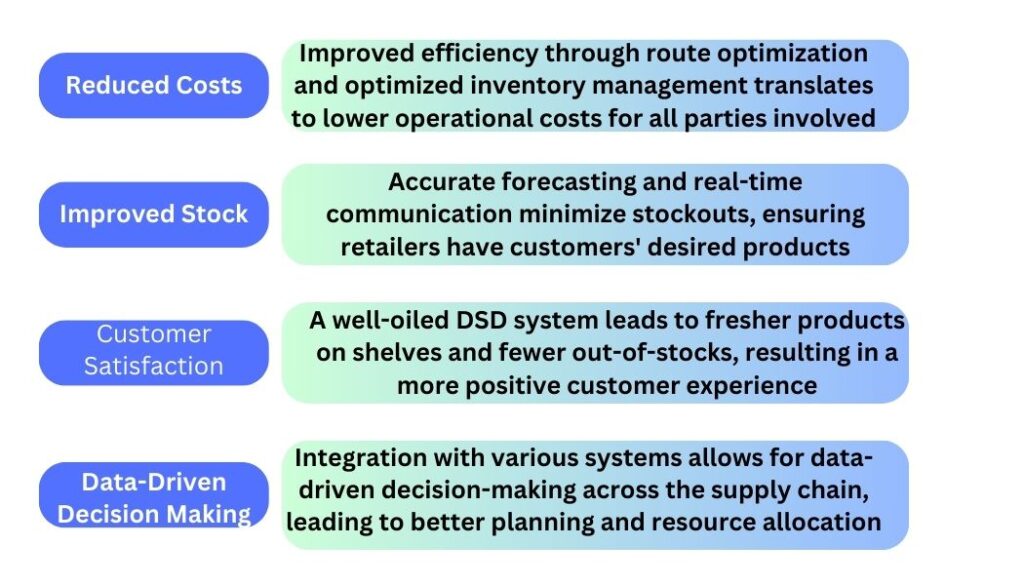
How DSD Collaboration and Integration Can Further Improve Efficiency
In a recent article, I examined the challenges a DSD operation faces in 2024. However, I have not dwelled on the opportunities to improve DSD’s efficiency and effectiveness through enhanced collaboration between manufacturers, distributors, and retailers and through integration with other systems. This article explores these opportunities for improvement through DSD Collaboration and integration.
Enhanced Collaboration: A Key to Success
Manufacturer-Retailer Collaboration: One primary way to improve DSD is through enhanced collaboration between manufacturers and retailers. By working closely together, manufacturers can better understand retailer needs and consumer demands, leading to more accurate and timely deliveries. On the other hand, retailers can benefit from the manufacturer’s insights into inventory management, shelf stocking, and merchandising strategies.
- Joint Planning and Forecasting: Manufacturers and retailers can engage in joint planning and forecasting activities to align their strategies and ensure product availability. Collaborative Planning, Forecasting, and Replenishment (CPFR) processes can help both parties share data and insights, reducing stockouts and overstock situations.
- Promotional Planning: Coordinating promotions between manufacturers and retailers can lead to more effective marketing campaigns and higher sales. Manufacturers can adjust their production schedules and delivery plans by sharing information on upcoming promotions to meet increased demand.
Distributor-Manufacturer Collaboration: Distributors play a crucial role in the DSD model as the link between manufacturers and retailers. Collaboration between distributors and manufacturers can lead to more efficient delivery processes and better inventory management.
- Real-Time Data Sharing: By sharing real-time data on inventory levels, delivery schedules, and sales trends, manufacturers and distributors can optimize their supply chain operations. This transparency can lead to more accurate replenishment orders and reduced lead times.
- Route Optimization: Manufacturers and distributors can collaborate to optimize delivery routes. Using advanced route planning tools and sharing delivery data can help minimize transportation costs and improve delivery times.
Retailer-Distributor Collaboration: Retailers and distributors can also enhance the DSD process by working closely together to ensure timely and accurate deliveries.
- In-Store Execution: Distributors can assist retailers with in-store execution, such as shelf stocking and display setup. This collaboration can lead to better product placement and increased sales.
- Feedback Loops: Establishing feedback loops between retailers and distributors can help identify and address issues quickly. For example, retailers can provide feedback on delivery performance, and distributors can make adjustments to improve service levels.
Integration with Other Systems: Streamlining Operations
ERP and Supply Chain Management Systems: Integrating DSD operations with Enterprise Resource Planning (ERP) and Supply Chain Management (SCM) systems can streamline processes and improve efficiency.
- Inventory Management: By integrating DSD with ERP systems, manufacturers and distributors can gain real-time visibility into inventory levels across the supply chain. This integration helps maintain optimal stock levels and reduce both stockouts and excess inventory.
- Order Processing: Automating order processing through ERP integration can reduce manual errors and speed up order fulfillment. Orders can be processed more efficiently, leading to faster deliveries and improved customer satisfaction.
Transportation Management Systems (TMS): Integrating DSD with Transportation Management Systems (TMS) can enhance delivery operations and reduce transportation costs.
- Route Planning and Optimization: TMS can optimize delivery routes based on traffic conditions, delivery windows, and vehicle capacities. This optimization reduces fuel consumption, transportation costs, and delivery times.
- Fleet Management: TMS integration is a comprehensive solution that covers all aspects of fleet management, including vehicle maintenance, driver schedules, and compliance with regulations. This leads to more reliable deliveries and reduced operational costs.
Customer Relationship Management (CRM) Systems: Integrating DSD with Customer Relationship Management (CRM) systems can improve customer service and strengthen retailers relationship.
- Customer Insights: CRM integration gives manufacturers and distributors valuable insights into customer preferences, purchasing patterns, and feedback. This information can be used to tailor products and services to meet retailer needs.
- Proactive Communication: By leveraging CRM data, manufacturers and distributors can communicate proactively with retailers about order status, promotions, and service issues. This approach builds trust and fosters long-term partnerships.
Benefits of a DSD Collaboration and Integration
The figure below summarizes the benefits expected through Collaboration and Integration.

The Future of DSD Collaboration
By fostering collaboration and integrating DSD with other systems, manufacturers, distributors, and retailers can create a more efficient, responsive, and customer-centric supply chain. As technology evolves, we can expect further advancements in automation, real-time data analytics, and even autonomous vehicles for deliveries, further optimizing the DSD model. Laceup Solutions’ integrated product suite fully supports DSD collaboration and integration. If you want to learn more, send us your information so we can schedule a meeting.
If you want to learn more about Laceup Solutions, send us your information so we can schedule a meeting.
I hope this article about DSD Collaboration and Integration has been helpful to you. I will continue to post information related to warehouse management, distribution practices and trends, and the economy in general.
There is a lot of relevant information on our YouTube channel. Check this video on Why DSD Distribution Still Works in 2024.


Sorry, the comment form is closed at this time.